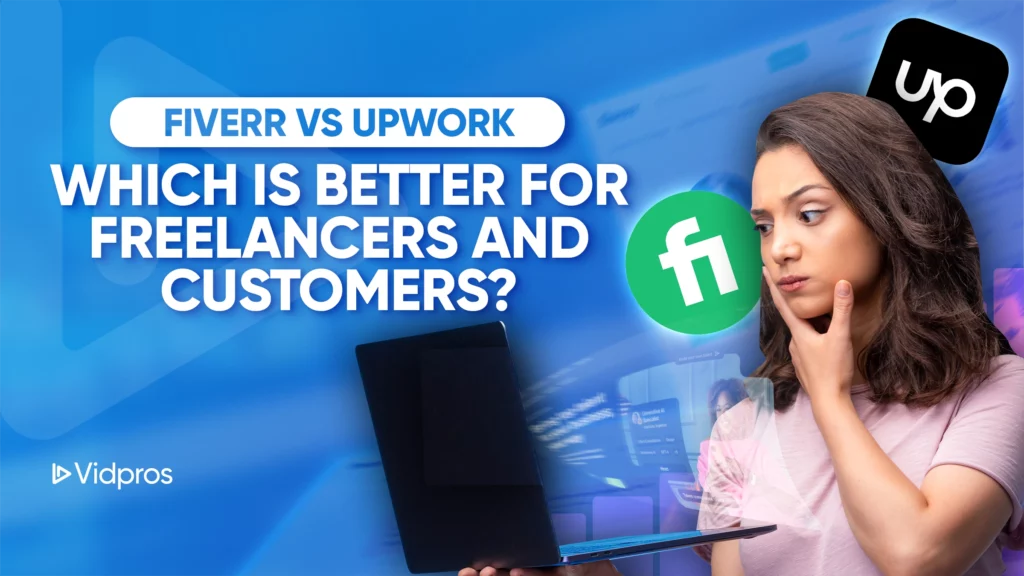Are you a new freelancer or a seasoned professional? Whether you are just starting out or have been in the industry for years, freelancers are always looking for opportunities to find work online.
Upwork and Fiverr are among the biggest freelance platforms for skilled professionals looking for jobs and clients who want to hire talent.
Although Fiverr and Upwork are similar, they also have some key differences.
Here, let’s talk about the similarities and differences between Fiverr and Upwork and how both platforms work for talented freelancers and customers.
What is Fiverr?

Fiverr is an Israeli-owned global freelance marketplace that connects freelancers and customers worldwide.
Some of the most popular categories on Fiverr include video editing, writing, website development, logo design, and SEO.
With Fiverr, customers are given access to a pool of top talents across 700 categories, enjoy a simple matching experience, get quality freelance work done quickly and within budget, and only pay when they are satisfied.
Customers (called “buyers”) can easily hire a remote worker (called “seller”) by searching for the freelance service they want and browsing among the pool of talents in one workflow.
Sellers show their skills through postings called “Gigs.” It allows buyers to choose the best one that fits their needs.

Fiverr has three pricing models to choose from:
- Fixed prices: Price is communicated upfront.
- Custom prices: Sellers can create a personalized package for the buyer according to their needs.
- Subscription: Sellers can provide specific services on an ongoing basis.
Once you have found a seller that fits your needs, you can share the needs of the project and request an order from them.
What is Upwork?

Upwork, formerly eLance-oDesk, is an American-owned freelance marketplace that aims to connect clients in need to professional freelancers who deliver.
With Upwork, you can create a free account that allows you to browse talent profiles, explore projects, and book a consultation.
Users can use the Upwork platform as freelancers, clients, or both.
Upwork allows customers to post a job to find the best freelancer for their project.
Freelancers can also create a posting in the Project Catalog that would allow customers to look for the freelancer that best fits their needs.
Freelancers use Connects to submit proposals to job posts by clients.
Each job post’s cost to submit a proposal varies. As a rule of thumb, job posts that are looking for full-time or long-term collaboration tend to cost more Connects.
Freelancers can also boost their proposals by using their Connects to bid for the highest ranks, which gives their proposals a higher chance to be viewed and selected.
After starting a contract, everything from project management to billing and payment happens inside Upwork. No need for third-party platforms!
Although users can use Talent Marketplace, Upwork Business Plus, and Project Catalog to browse for talents for free, customers pay a contract initiation fee, which ranges from $0.99 to $14.99, as an initial payment on a new contract.

Payments on the same contracts have a 5% transaction fee. Freelancers also pay a 10% service fee when they collect their earnings.
Upwork also has an enterprise tier for businesses that are looking into hiring freelancers instead of the traditional staffing model.

In this tier, Upwork helps clients move projects across a finish line, adapt and expand the workforce, add more talent to the roster, and delegate tasks to the team.
Upwork Enterprise has the following benefits:
- Personalized chatbot or agent
- High-quality labeled data
- AI solutions delivered by expert-vetted talent
Upwork is a good place to create lasting client relationships or a one-time collaboration.
Key Differences Between Fiverr and Upwork
Although Upwork and Fiverr both serve the same purpose, that is, to bring customers and freelancers to one platform, they have a few key differences that potential customers must take into consideration.
User-friendly Interface
Upwork’s workflow ensures that clients cannot start a contract without consent and acceptance from the freelancer, making sure that both parties are on the same page before starting the project.
When it comes to the Project Catalog, both the customers and freelancers are allowed to cancel an order with no penalty for 24 hours.
This feature is necessary when you purchase a project but want to change the contract to an hourly contract.
It is also essential when you accidentally purchase the wrong project or realize that the freelancer is not the best fit for your needs.
This feature is also helpful, especially if you forget to deactivate your Project Catalog listings and you cannot take on other work for the time being.
However, on Fiverr, it is not easy to change the gig’s direction once the buyer has purchased it.
Moreover, gig cancellations can be detrimental to a seller’s rating, even if the buyer canceled the gig.
UpWork also allows customers to find a job or talent with its filtering tools based on the category of work, hourly or fixed payment, project length, etc.

In contrast, sellers on Fiverr cannot browse job listings. Instead, buyers can browse and filter sellers according to service options, seller level, location, etc.
Control
Fiverr allows buyers to have full control over the hiring process. Once they have created an account, they can search for the services they need and find the best fit for the job.
Buyers can also review profiles and compare prices with minimal effort.
In contrast, Upwork allows customers to post their job offerings, allowing them to evaluate the candidates before choosing one they want to work with.
However, due to Upwork’s huge talent pool, it would take time to assess whether each candidate fits your needs.
Time to Value
This is one of the main differences between Fiverr and Upwork.
With Fiverr, buyers can easily find freelancers and get projects rolling. Fiverr’s AI assistant, Neo, also speeds up the process by providing real-time recommendations.
In contrast, Upwork requires customers to set up a profile, create a job post, wait for freelancers to submit proposals, assess the proposals, and talk to freelancers to see if they are a good fit.
Although its AI tools can speed up the process, it is still time-consuming.
Upwork vs Fiverr: For Freelancers
Here are the in-depth differences between Upwork and Fiverr for freelancers:
Popular Jobs
Fiverr offers a wide range of services. Popular types of jobs include:
- Digital marketing
- Content writing
- Video and animation
- Graphic design
- Programming and tech
- Software development
Meanwhile, the popular job categories on Upwork include:
- Accounting and consulting
- Customer service
- Admin support
- Design
- Writing
Finding Freelancers
Fiverr’s layout allows buyers to browse gigs easily. It also has a search function that filters by delivery, budget, and services.
The best options are shown up front, with quick access to basic information about the seller without clicking the profile.
Meanwhile, Upwork clients post job requests and wait for freelance professionals to submit proposals.
Upwork, unlike Fiverr, does not highlight the best talent automatically. You need to filter it manually by hourly rate, skill, location, hours billed, etc.
Upwork also offers a Project Catalog wherein freelancers can post predefined services like Fiverr.
User Experience
Fiverr’s structure is organized and straightforward.
After finding freelancers you want to work with, you can simply choose the package you want, and it will take you to the checkout page for payment.
In contrast, Upwork has a detailed onboarding process.
Customers are required to fill out a profile before they can post jobs.
However, Upwork’s AI tool, Uma, helps buyers write job descriptions and find freelancers, just like Fiverr’s Neo.
Freelance Vetting
Fiver requires freelancers to create a detailed profile showing their skills and portfolio. They are also required to submit a valid ID.
Fiverr also makes it easy to spot top talents by identifying seller levels. Here are the following performance metrics to determine seller levels:
- Success score
- Rating
- Response rate
- Orders
- Unique clients
- Earnings
Currently, Fiverr has three seller levels.
In contrast, Upwork relies on the Job Success Score (JSS) to measure a client’s satisfaction with a freelancer’s work.
A JSS score of 90% or higher is deemed excellent and is one of the criteria for the Top Rated status.
Upwork’s Top Rated status is given to freelancers who consistently meet the following criteria:
- A JSS score of at least 90% for at least 13 out of the last 16 weeks
- Has at least $1,000 of earnings over the past 12 months
- Active in the platform within the last 90 days
- Has an account in good standing with no recent disputes
Cost
Fiverr offers fixed-priced gigs, ranging from $5 to hundreds of dollars, depending on the project.
It accepts payment through Apple Pay, Fiverr Balance, credit/debit cards, Google Pay, Paypal, and wire transfers.
Fiver also has a Pro Rewards Program that offers exclusive benefits based on annual spending. It includes three tiers: Silver, Gold, and Platinum.
In contrast, Upwork allows clients to hire freelancers on an hourly or fixed-price project.
Accepted payment methods on Upwork include credit cards, PayPal, and bank transfers.
UpWork vs Fiverr: For Customers
Here are the in-depth differences between Upwork and Fiverr for customers:
Finding Freelance Jobs
On Fiverr, freelancers can post gigs for free, which is a significant cost-saver for sellers.
A seller can create and publish a gig easily by filling in the required fields and then clicking Publish.

In contrast, Upwork requires freelancers to use Connects to send proposals. Each month, freelancers get 10 Connects for free. However, if you need more, you need to purchase them.

Rising Talent, Top Rated, and Top Rated Plus freelancers get 30 free Connects for each badge.
Cost as a Freelancer
Here is the breakdown of how fees work on Fiverr:
- Commission fee: All transactions on Fiverr, including extras and add-ons, are charged with a 20% commission, regardless of the size of the project.
- Payment clearance period: For standard sellers, funds become available for withdrawal 14 days after order completion. Meanwhile, for Top Rated, Seller Plus Premium, and Pro Sellers, the clearance period is only 7 days.
- Early payout: This is only available to eligible sellers. It allows sellers to withdraw earnings for a fee before the standard clearance period.
In contrast, this is how fees work on Upwork:
- Service fee: All client payments on Upwork are charged with a 10% service fee for all types of projects.
- Payment availability: Funds are available for withdrawal 5 days after the client releases the payment.
The Bottomline
Both Upwork and Fiverr are fantastic freelance talent marketplaces for anyone who wants to find freelancers or jobs.
Freelance talents can find success on these platforms. However, their differences show that they cater to different clients.
Upwork is a platform that allows customers to create a job posting, which can be time-consuming.
In contrast, Fiverr sellers post their gigs, and buyers can choose which one to purchase, making the process more streamlined and seamless.
However, once you have purchased a gig, it is difficult to change the direction of the project or cancel the gig, as it will reflect on the seller’s rating.
If you want to outsource your video editing needs to a reliable team, look no further! We at Vidpros are dedicated to lifting the burden off your shoulders so you can focus on creating engaging content.
Book a free consultation call with us today!













